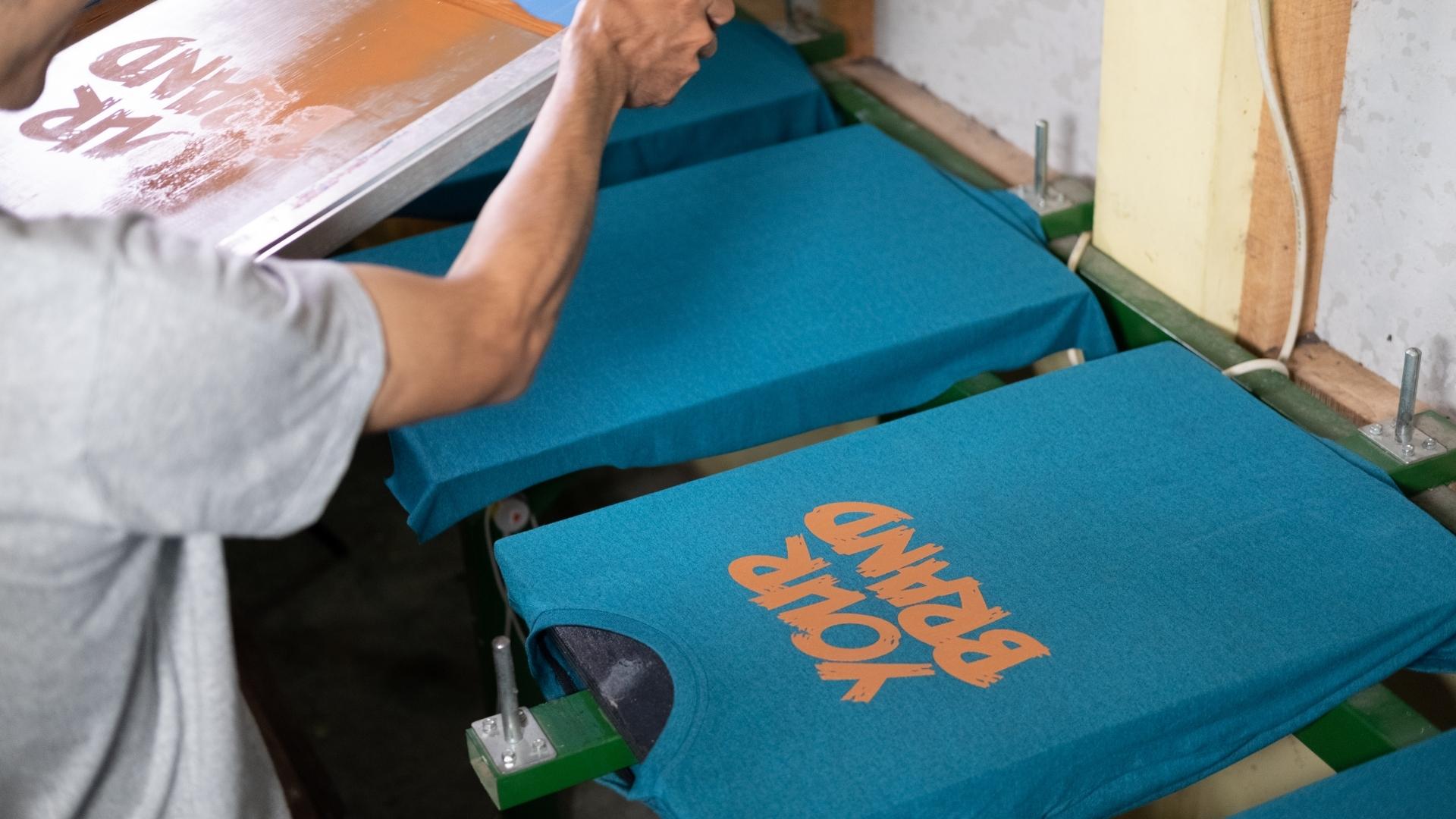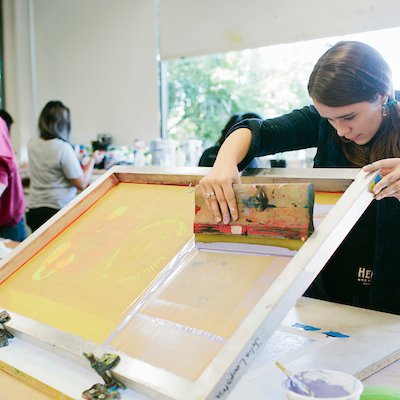ChatGPT said: How to customize your apparel with 10:9 Design Screen Printing in 3 easy steps
Discover the Various Kinds Of Screen Printing Techniques for Your Following Project
Screen printing offers a diverse array of methods that can boost any type of innovative project. From typical techniques like serigraphy to modern-day advancements such as direct-to-garment printing, each strategy has its one-of-a-kind advantages. Specialty alternatives, including metallic and environmentally friendly inks, introduce a lot more possibilities. Recognizing these strategies can greatly affect the last result. However, the obstacle hinges on picking one of the most appropriate approach for certain demands and desired results. What factors should one consider?

The Fundamentals of Screen Printing
Although screen printing may appear facility, it is fundamentally a simple process that entails moving ink through a mesh screen onto numerous surface areas. The method starts with the creation of a pattern, which specifies the layout to be printed. This stencil is connected to a mesh screen, usually made from polyester or nylon. Once the stencil is in location, ink is related to the screen and pushed through the mesh using a squeegee, resulting in the desired pattern being published on the underlying material.
Screen printing can be carried out on a vast array of substrates, including plastic, paper, and material, making it a flexible option for different tasks. The procedure allows for complex styles and dynamic colors, making it popular in industries such as art, fashion, and advertising. Recognizing these fundamentals outfits individuals with the foundational knowledge required to explore advanced techniques in screen printing.
Conventional Screen Printing Techniques
Typical screen printing techniques have been utilized for centuries, preserving the craftsmanship and virtuosity of this method. This strategy uses a mesh screen to transfer ink onto a substrate, such as material or paper, permitting for long-lasting and vivid designs. The procedure begins with creating a stencil, which obstructs certain locations of the screen to control where the ink will be applied.
One popular method is serigraphy, often used for limited versions and imaginative prints. One more is the use of water-based inks, which are environment-friendly and provide a soft feeling on textiles - 10:9 Design Embroidery. Furthermore, standard methods can consist of manual printing, where craftsmens apply ink with a squeegee, guaranteeing precision and interest to information
These techniques stay valued in the industry for their responsive high quality and the unique appearances they generate, interesting both designers and consumers that appreciate the heritage of screen printing.
Digital Screen Printing Innovations
As the demand for faster manufacturing and customization in the printing industry has surged, digital screen printing innovations have arised as a game-changer. This technology mixes conventional screen printing approaches with electronic processes, permitting for fast prototyping and complex layouts that were formerly hard to attain. One considerable improvement is the introduction of direct-to-garment (DTG) printing, which helps with top notch, full-color prints on different fabrics without the requirement for screens. Additionally, developments in ink formulations have resulted in environment-friendly alternatives that maintain dynamic shades while minimizing ecological impact. The use of automated systems better improves manufacturing, decreasing labor prices and enhancing accuracy. These innovations not only accommodate small batch orders and individualized designs but additionally enable for quicker turnaround times, making them suitable for services focused on conference customer needs in a fast-paced market. Digital screen printing, consequently, stands for a vital evolution in the domain name of printing techniques.
Specialty Screen Printing Approaches
Checking out specialty screen printing approaches reveals a varied selection of strategies that push the limits of creativity and performance in the printing industry. Among these, glow-in-the-dark inks supply a special aesthetic impact, making designs come alive in low-light conditions. Metallic inks, understood for their sparkling finish, add a touch of luxury to printed products. An additional cutting-edge approach is discharge printing, which removes color from the textile rather of adding ink, resulting in a soft, classic feeling. High-density printing produces an increased texture externally, boosting responsive interaction. In addition, water-based inks are acquiring popularity for their vibrant colors and minimized ecological impact. Each of these specialty methods provides to details design requirements, making it possible for brand names and artists to develop standout items that resonate with their audiences. By leveraging these techniques, organizations can elevate their screen printing jobs to new elevations, ensuring remarkable perceptions.
Eco-Friendly Screen Printing Options
Environment-friendly screen printing choices are acquiring grip as the sector moves towards sustainability. Sustainable ink options and making use of biodegradable materials are vital parts in decreasing the environmental impact of the printing process. By embracing these methods, screen printers can add to a much more sustainable future while maintaining top notch outcomes.
Lasting Ink Options

Biodegradable Products Use
As the screen printing industry evolves, the unification of biodegradable products is ending up being significantly essential for eco conscious methods. Producers and designers are currently discovering inks and substratums made from all-natural, renewable energies that disintegrate a lot more effectively than conventional counterparts. These naturally degradable alternatives reduce plastic waste and decrease ecological influence, lining up with the growing demand for lasting items.
Usual instances consist of water-based inks and natural cotton materials, both of which reduce dangerous chemicals and advertise eco-friendliness. Brand names that take on these materials frequently enhance their market allure, drawing in customers that focus on sustainability. As recognition of environmental issues proceeds to increase, the change in the direction of eco-friendly materials in screen printing is most likely to get energy, promoting a greener sector standard.
Selecting the Right Strategy for Your Project
Exactly how can one identify one of the most ideal screen printing method for a certain job? The decision hinges on several variables, consisting of the product to be printed on, the intricacy of the layout, and the preferred manufacturing volume - 10:9 Design Company. Direct-to-garment printing is perfect for intricate designs with various shades, while traditional screen printing excels for larger runs of less complex graphics.
In addition, consideration of the end-use of the published thing is vital. For exterior applications, strategies that offer toughness and weather condition resistance, such as plastisol ink, may be liked. Alternatively, environmentally-conscious projects may take advantage of biodegradable products or water-based inks.
Eventually, understanding the task's distinct needs enables an informed option, ensuring both aesthetic allure and useful durability. By examining layout intricacy, material compatibility, and manufacturing scale, one can successfully select the most proper screen printing method to fulfill their project's goals.
Regularly Asked Questions
What Is the History of Screen Printing?
Screen printing originated in old China around 1000 ADVERTISEMENT, progressing with Japan and Europe. By the 20th century, it became popular in commercial art and fashion, transforming how designs were generated and dispersed internationally.

How Do I Prepare Artwork for Screen Printing?
To prepare art work for screen printing, one must assure high resolution, utilize an appropriate shade setting, create different layers for each and every color, and transform text to outlines, ensuring compatibility with the printing procedure and wanted outcome.
What Products Are Finest for Screen Printing?
The most effective products for screen printing include premium inks, resilient displays, and suitable substratums like cotton, polyester, or blends. Additionally, making use of suitable emulsion and mops can enhance the printing process and final results.
Can I Evaluate Print in your home?
Yes, screen printing at home is feasible. With the appropriate products, setup, and techniques, individuals can create top notch prints. Nevertheless, mindful consideration of work area and devices is crucial for effective results.

What Prevail Mistakes in Screen Printing?
Usual blunders in screen printing include incorrect exposure times, inadequate ink uniformity, misalignment of displays, insufficient cleansing of products, and overlooking to test prints. These mistakes can compromise the high quality and precision of the final item.
Screen printing might seem facility, it is fundamentally an uncomplicated process that includes moving ink with a mesh screen onto numerous surfaces. As the need for faster manufacturing and personalization in the printing industry has surged, electronic screen printing technologies have emerged as a game-changer. Discovering specialized screen printing techniques discloses a diverse array of methods that push the boundaries of creativity and capability in the printing market. The best products for get more info screen printing include top quality inks, sturdy screens, and appropriate substrates like cotton, polyester, or blends (10:9 Design Screen Printing). Typical mistakes in screen printing include incorrect direct exposure times, poor ink uniformity, misalignment of displays, insufficient cleansing of products, and overlooking to check prints